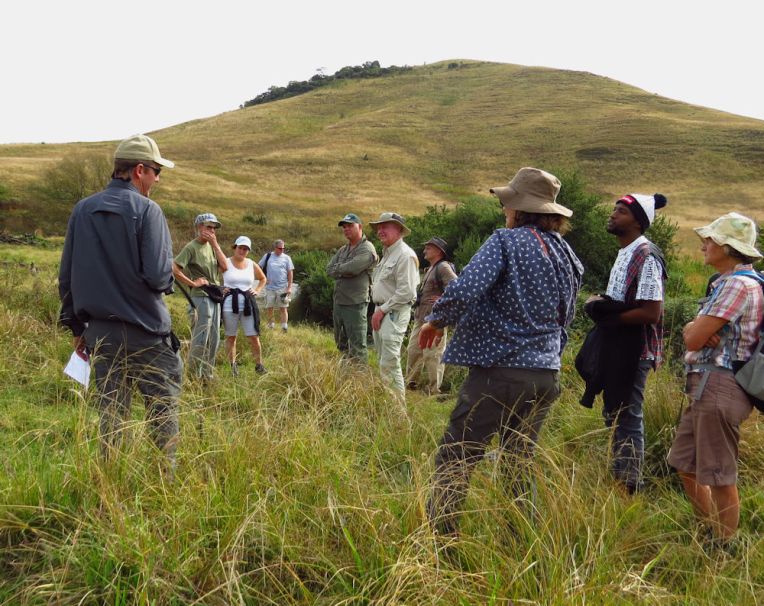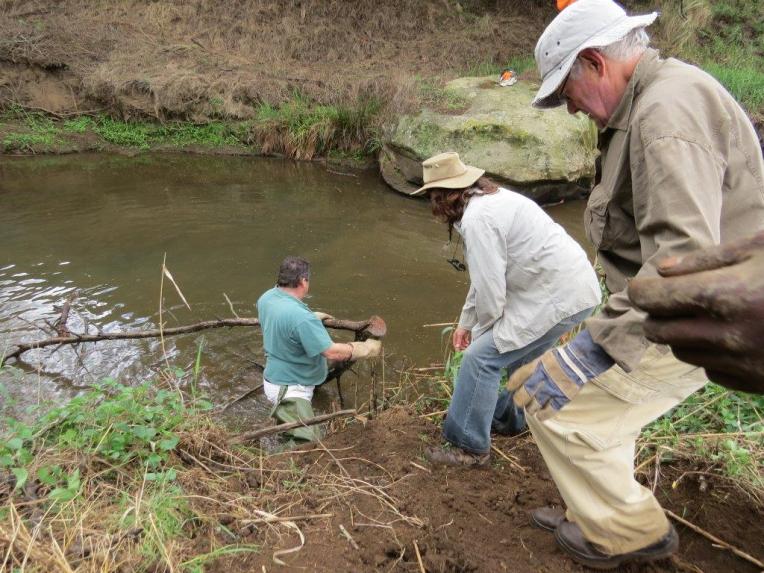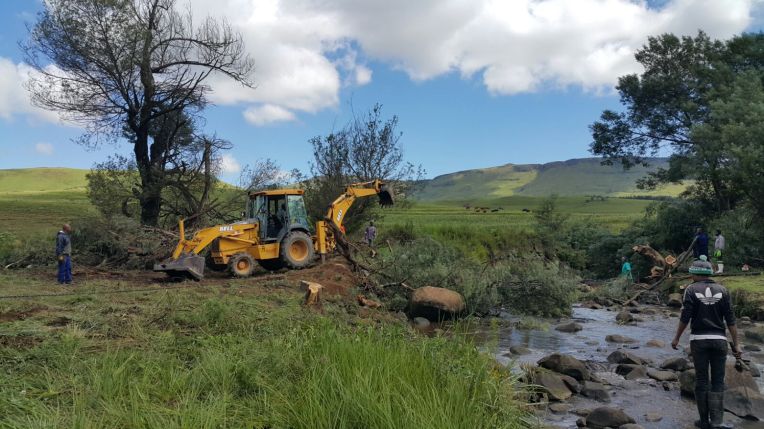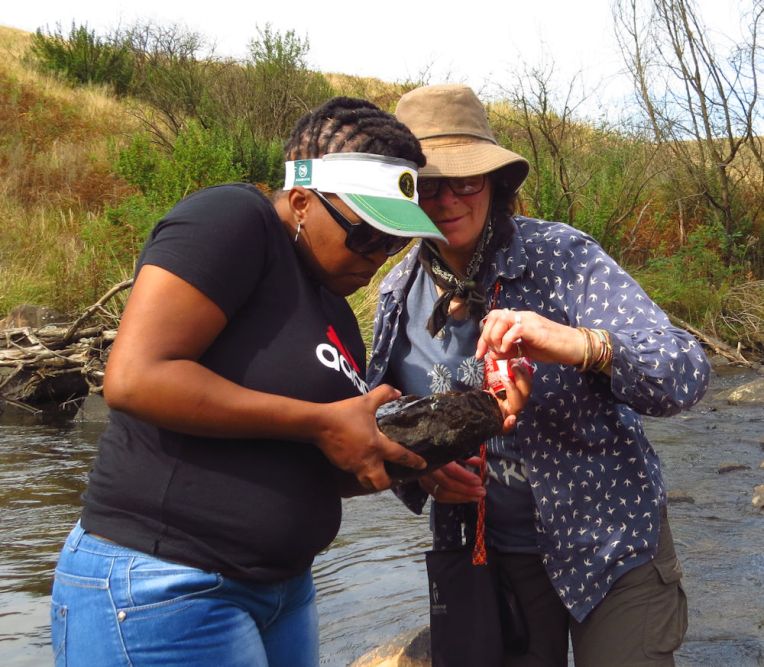The uMngeni was one of the first three rivers to be stocked with trout in May of 1890 (the others being the Bushmans River and the Mooi River).
Four generations of the Fowler family have grown up on the banks of the uMngeni and Andrew Fowler has fished it since the 1980s. Since 2013, Andrew has lead the Natal Fly Fishers Club doing exceptional work clearing invasive plants along the banks of the uMngeni in Upper Dargle, contributing to improved water resources for millions of downstream users. On Saturday, a group of river enthusiasts joined him for a seven kilometre walk along the banks to celebrate his passion for this river and the improvement to the riparian zone.

The river rises in uMngeni Vlei on a plateau between Fort Nottingham and Impendle and ambles just a few kilometres before plunging down a wooded kloof. Where it exits that kloof, it runs under a public road, and from there on down for just 17 kms, it is a viable trout stream. Where it runs under the bridge on the Dargle Impendle road, just moments before plunging over the Dargle Falls, marks the lower end of the trout water. 11km of that 17km stretch, is accessible to the public through the Natal Fly Fisher’s Club (NFFC). Over the past 30 years, club members have experienced insidious environmental degradation. Andrew’s mission is to reverse that.

Andrew tells us “As fly-fishermen, our interest in clearing the river is driven by a desire for a river which is less prone to siltation, more diverse in its aquatic and terrestrial insect population, and is therefore more suited to healthy fish populations. We desire well grassed banks, devoid of exotic invasive species that shade and denude, and better water flows. Easier going and casting are very much secondary benefits and are not the main aim at all. We are therefore supportive of clearing all the tributaries, and land in the catchment, and desire a restored grassland landscape with a healthy biodiversity, in which we are more likely to encounter wildlife and birdlife. The #BRU (Blue Ribbon uMngeni) initiative hopes to extend beyond just the farms to which the fishermen have access, in the interests of the entire catchment and river, and is intended to endure for the long run. It is our intention to hold annual clearing days in which follow up work is done to control wattle regrowth. Promoting the uMngeni as a great trout fishery, to ensure that it attracts future guardians, is also key to the long term success of our endeavours.”
 While the trout fishermen have their own reasons for making this effort, the result is improved water for 6 million downstream users. The uMngeni catchment is not very big and huge demands are made on this river for farming, industrial and household use.
While the trout fishermen have their own reasons for making this effort, the result is improved water for 6 million downstream users. The uMngeni catchment is not very big and huge demands are made on this river for farming, industrial and household use.
A synopsis of NFFC efforts so far:
The volunteer days in 2013 and 2014 saw relatively light work take place with members using their own chainsaws and spraying equipment, removing alien plants from the South bank of the Umgeni, starting on Brigadoon (owned by Russell Watson) and working upstream.
In 2015 about half a km above where the Furth stream enters the Umgeni, NFFC sponsored a team of contractors and Russell Watson provided tractors, staff and TLB, while volunteers joined in the effort to clear 1.5 kms. On a follow up day, volunteers sprayed bramble on about 3kms of river bank.

In 2016, two more volunteer days were held, where work was continued upstream onto the adjoining farm Furth. On one of those days there were only volunteers, on another a donation enabled a hired team of eight chainsaw operators. These days achieved clearing around 1.2 kms of water, again largely on the South bank.

In April of 2016, two days were held where a large team of contractors were joined by a DUCT team and Russell Watson’s tractors, TLB and staff. This was funded by the proceeds of Andrew Fowler’s book, Stippled Beauties and Anton and Alison Smith. Over two days, both banks were completely cleared of wattle, and all trees were dragged out of the river channel, leaving a stretch of about a km completely transformed.
In May, schoolboys from Michaelhouse and St Johns College (JHB) were hosted on Chris Howie’s and William Griffin’s properties, where wattle regrowth and bug weed were cleared. Saws, pangas and gloves were sponsored by the NFFC and TWK in Howick, and DUCT supplied chemicals to stop regrowth.
 Two days of clearing with contractors and casual labour took place in late August along the South bank – made possible by a R10 000 donation from the Natal Fly Fishers Club. In October 2016 a volunteer day sprayed bramble for 2 kms along the banks.
Two days of clearing with contractors and casual labour took place in late August along the South bank – made possible by a R10 000 donation from the Natal Fly Fishers Club. In October 2016 a volunteer day sprayed bramble for 2 kms along the banks.

Andrew engages riverside landowners as much as possible. He has been very impressed with the work Don McHardy has done clearing the banks of properties near the road bridge across the uMngeni. He is in discussion with landowners to clear areas on Rathmines and Ross Poultry properties.
Andrew discusses his preferred methods of working. “A team of labourers with a few chainsaws will be able to do a lot, but will not be able to fell and drag big trees. Also, those big trees are often best dragged out on the flatter side of the river, even if they were felled on the other side – for this e need tractors and a TLB. We believe it is very important not to fell trees into the river and leave them there to create logjams. We prefer to drag them free of the floodplain, and if there is a bare steep slope nearby, we lay them across the slope (on the contour) to assist erosion prevention. In Spring we plan to plant a seed mix of Teff and eragrostis or veld mix in places that have bare ground as a result of felling, to prevent erosion and provide a ground cover that will limit regrowth of wattles.”

Everyone who joined Andrew to explore the area was most impressed. Penny Rees, who had walked this section with her DUCT River Walk team exactly five years ago, was thrilled at the improvements. “We couldn’t actually walk on the bank here because it was so thick with wattle,” she enthused.

This is a dairy and beef farm, so there was much discussion about the effect on the water quality of nutrification from cattle manure and fertilizer used to grow grass. Pearl Gola observed “If the riparian buffer zones were wider (the legal requirement is 32m) many of the excess nutrients would be filtered out by the natural vegetation before entering the river.” Judy Bell added “By bringing the fences back from the edge of the river, one would also create corridors for the movement of wildlife.”

There were plenty of log jams created by fallen wattle trees. It was very clear how these slowed down the flow and caused siltation upstream. While in rivers in America indigenous beavers actually build such barriers, here in KZN the streams never had trees along them – simply meandering through grassland, so these piles of alien branches in the river have no positive function.

All morning, Inhlosane towered above us, enticing us along the banks through rye grass paddocks and grassland.

Besides all the interesting discussion about trout and water and river health, we were thrilled to observe Jackal Buzzards right overhead, a Bushbuck emerging from the Ouhout thicket and a number of Reedbuck watching us from the top of a hill.

We were delighted when Andrew lead us towards some rapids and a cooler box filled with ice cold drinks, taking the opportunity to kick of our shoes and paddle in the cold water so loved by trout. Someone even spotted one!

The citizen scientists among us were unable to resist the opportunity to explore the riverbed rocks for invertebrates (which give an indication of the health of the river). We turned over stones and found minute prongills and caddisfly larvae.

Chair of Dargle Conservancy, Nikki Brighton, thanked Andrew for his efforts on behalf of the well-being of the wider community and biodiversity. “Water does not come from a tap – it comes from the hills and wetlands – the ‘water factories’ – of the Midlands. Much of the original grassland riparian zone is degraded – most often with invasive plants like wattle, bramble and bamboo, which transform the natural landscape and overrun the original biodiversity. The plants shade the water, change the temperature and the aquatic biodiversity, and dense stands prevent animals accessing the water. When this ecosystem is weakened water quality is affected. Six million people live downstream of the water catchment in Dargle, relying on correct management of this natural resource to provide their daily water. Andrew’s passion for the river has a positive impact way beyond Dargle.”
The Dargle Conservancy have made Andrew an Honorary Life Member of the organisation and presented him with a Dargle Dassie Certificate thanking him for his contribution to conservation.

Andrew concludes “I am truly excited by what we have been able to achieve on some short stretches of river. The results are fantastic, but we have to be realistic and realise that the stream’s biodiversity will take time to recover fully. Added to the conservation efforts of WWF in the area, Working for Water’s programme, the Dargle Conservancy clearing along the Dargle River, the River Walk team lead by Penny Rees and the sterling work of DUCT further downstream, there is a real groundswell of support for this river. This is true conservation, not just banners and bumper stickers. The enthusiasm has been infectious, and many members of the NFFC have displayed commitment and passion. Having been part of these days, I can personally attest to the camaraderie and drive as the guys get stuck in, dragging logs and cutting branches until their backs ache. I am proud to be part of it.”
Progress can be tracked on the Blue Ribbon Umgeni blog site.


2 thoughts on “Blue Ribbon uMngeni”